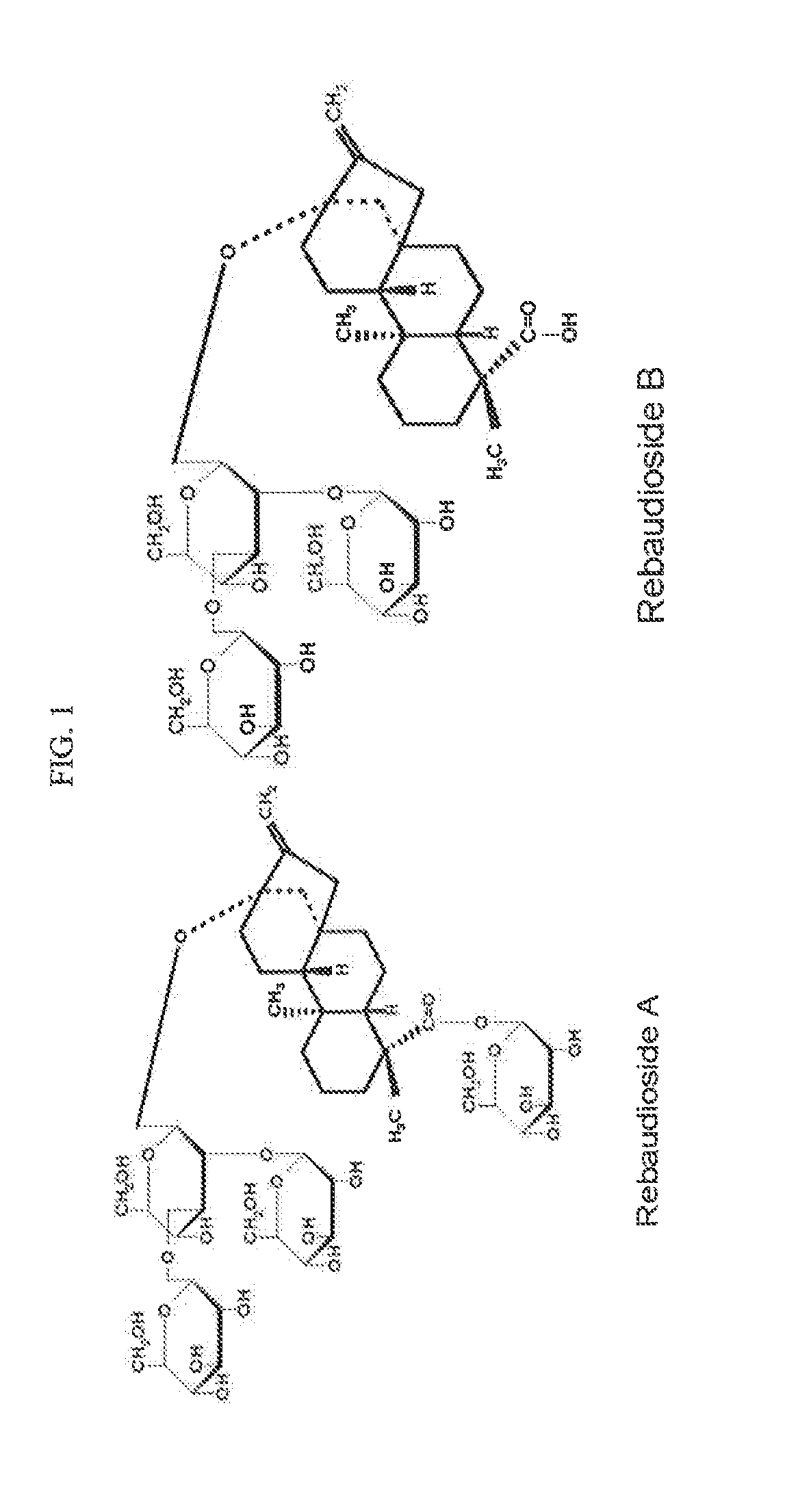Stevia composition to improve sweetness and flavor profile
a technology of stevia and composition, applied in the field of sweetener compositions, can solve the problems of inability to meet the needs of consumers, inability to perceive the artificial nature and safety concerns of such sweeteners, and inability to achieve the effects of improving taste and sweetness, reducing the risk of adverse effects, and improving the taste and flavor profil
- Summary
- Abstract
- Description
- Claims
- Application Information
AI Technical Summary
Benefits of technology
Problems solved by technology
Method used
Image
Examples
example 1
Determination of Sweetness Profile of Steviol Glycosides
[0046]Stevia sweetener (Reb A, Reb B, Reb C, Reb D and stevioside) solutions were made by completely dissolving 200 ppm stevia sweeteners into distilled water. Solutions were tasted and evaluated by a trained internal panel. The taste panel estimated the sweetness intensity and associated sweetness profile including sweet onset, after tastes that include bitterness, liquorish and sweet lingering of different steviol glycosides as shown in FIG. 3. It illustrates the superior taste profile of Reb D over other steviol glycosides, specifically in the area of lower bitterness, cleaner and overall sweet taste profile.
example 2
Preparation of Blends of Reb A, Reb B and Reb D Concentrated Solutions
[0047]The PCT application PCT / US2012 / 051163 illustrates the methodology to make higher soluble Reb D samples. Several concentrated suspensions of Reb D and mixtures of Reb D (RD) with Reb A (RA) and Reb B (RB) were prepared (as shown in Table 2), where sweetener to water ratio was 20:80. The Reb A, B, D samples were produced by PureCircle Sdn Bhd (Malaysia) and had 98.7%, 99.0% and 98.1% purity, respectively. The sweetener suspensions were incubated in thermostatic oil bath. The temperature was increased at 1° C. per minute to 121° C. The mixture was maintained at 121° C. for 1 hour and then the temperature was decreased to 80° C., at 1° C. per minute. A small portion of each solution was kept at 80° C. and observed for solution stability. Rest of the solution, maintained at 80° C., was then spray dried using YC-015 laboratory spray drier (Shanghai Pilotech Instrument & Equipment Co. Ltd., China) operating at 175°...
example 3
Sweetness Potency of Reb A, Reb B, Reb D and their Blend
[0049]Several sweetener solutions of sugar, Reb A, Reb B and Reb D samples were made by completely dissolving different amount of sweeteners into distilled water. Solutions were tasted and evaluated by a trained internal panel to develop iso-sweet curves for each sweetener against sugar solutions as shown in FIG. 4. Similar iso-sweet data was generated for a blend (called Delta) of Reb A, Reb B and Reb D prepared by the methodology outlined in Example 2. The sweetness potency values (FIG. 5) were calculated at each sugar-equivalent sweetness level for individual and a blend (Delta) of Reb D, Reb A and Reb B sweeteners.
PUM
 Login to View More
Login to View More Abstract
Description
Claims
Application Information
 Login to View More
Login to View More - R&D
- Intellectual Property
- Life Sciences
- Materials
- Tech Scout
- Unparalleled Data Quality
- Higher Quality Content
- 60% Fewer Hallucinations
Browse by: Latest US Patents, China's latest patents, Technical Efficacy Thesaurus, Application Domain, Technology Topic, Popular Technical Reports.
© 2025 PatSnap. All rights reserved.Legal|Privacy policy|Modern Slavery Act Transparency Statement|Sitemap|About US| Contact US: help@patsnap.com



